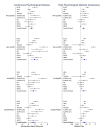Living alone and mental health: parallel analyses in UK longitudinal population surveys and electronic health records prior to and during the COVID-19 pandemic
- PMID: 37562853
- PMCID: PMC10577768
- DOI: 10.1136/bmjment-2023-300842
Living alone and mental health: parallel analyses in UK longitudinal population surveys and electronic health records prior to and during the COVID-19 pandemic
Abstract
Background: People who live alone experience greater levels of mental illness; however, it is unclear whether the COVID-19 pandemic had a disproportionately negative impact on this demographic.
Objective: To describe the mental health gap between those who live alone and with others in the UK prior to and during the COVID-19 pandemic.
Methods: Self-reported psychological distress and life satisfaction in 10 prospective longitudinal population surveys (LPSs) assessed in the nearest pre-pandemic sweep and three periods during the pandemic. Recorded diagnosis of common and severe mental illnesses between March 2018 and January 2022 in electronic healthcare records (EHRs) within the OpenSAFELY-TPP.
Findings: In 37 544 LPS participants, pooled models showed greater psychological distress (standardised mean difference (SMD): 0.09 (95% CI: 0.04; 0.14); relative risk: 1.25 (95% CI: 1.12; 1.39)) and lower life satisfaction (SMD: -0.22 (95% CI: -0.30; -0.15)) for those living alone pre-pandemic. This gap did not change during the pandemic. In the EHR analysis of c.16 million records, mental health conditions were more common in those who lived alone (eg, depression 26 (95% CI: 18 to 33) and severe mental illness 58 (95% CI: 54 to 62) more cases more per 100 000). For common mental health disorders, the gap in recorded cases in EHRs narrowed during the pandemic.
Conclusions: People living alone have poorer mental health and lower life satisfaction. During the pandemic, this gap in self-reported distress remained; however, there was a narrowing of the gap in service use.
Clinical implications: Greater mental health need and potentially greater barriers to mental healthcare access for those who live alone need to be considered in healthcare planning.
Keywords: COVID-19; anxiety disorders; psychiatry.
© Author(s) (or their employer(s)) 2023. Re-use permitted under CC BY. Published by BMJ.
Conflict of interest statement
Competing interests: None declared.
Figures



References
-
- Klinenberg E. Going solo: the extraordinary rise and surprising appeal of living alone. London: Duckworth, 2013.
-
- Office for National Statistics . Families and households in the UK: 2021. Newport, UK: Office for National Statistics, 2022. Available: https://www.ons.gov.uk/peoplepopulationandcommunity/birthsdeathsandmarri...
-
- Office for National Statistics . The cost of living alone. Newport, UK: Office for National Statistics, 2019. Available: https://www.ons.gov.uk/peoplepopulationandcommunity/birthsdeathsandmarri...
Publication types
MeSH terms
Grants and funding
LinkOut - more resources
Full Text Sources
Medical
Miscellaneous
